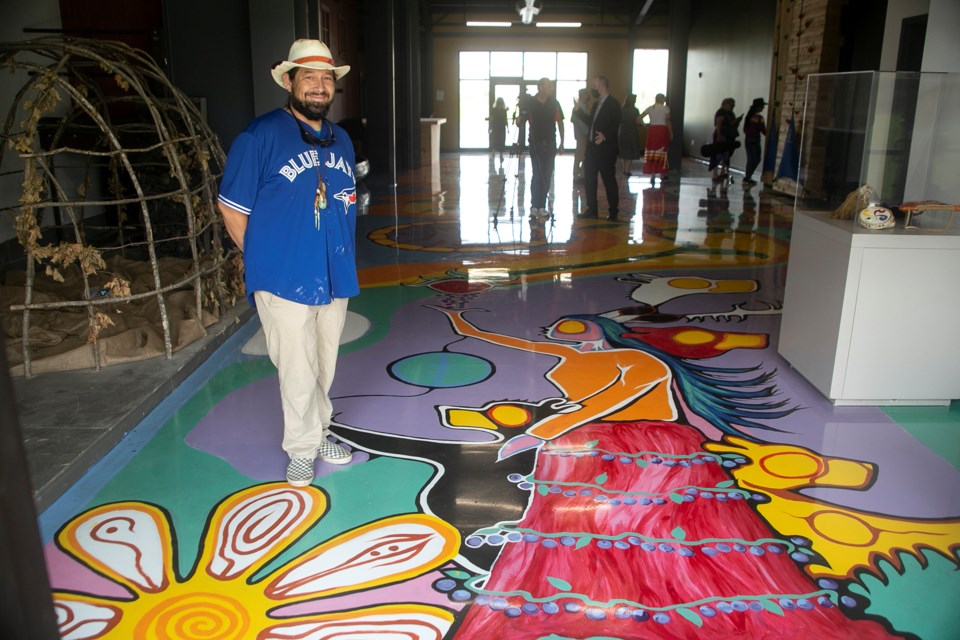When the new Agawa Canyon Tour Train station opens its doors to visitors in September, it will greet them with a new community space filled with Indigenous artwork and teaching elements.
On Tuesday, a ribbon-cutting ceremony was held for the new station at the Canal District and the people who attended were offered a sneak peek at the interior.
The front-facing doors lead to the ticket counter for the Agawa Canyon Tour Train, but a new community space is part of the project, as well as a microbrewery and restaurant.
The floor of the community space is dominated by an arresting mural that runs the entire width of the station. Artist Tom Sinclair said it took about 10 days for him and and assistant to complete it.
The mural is packed with symbolism. It begins with a depiction of Mother Earth kneeling on a snapping turtle and painted turtle.
“She is wearing a red dress for the Missing and Murdered Indigenous Women and Girls and she is wearing an orange shirt to represent the residential school survivors,” said Sinclair.
He said he didn’t want to shy away from those issues that are now firmly in the public’s consciousness.
“I want to get and share as much of this as I can in a good and positive and colourful way,” said Sinclair. “There is so much history that I think needs to be acknowledged.”
The depiction of Mother Earth is holding a red strawberry, which Sinclair said represents Sault Ste. Marie. A vine is painted growing from the strawberry, which represents the Algoma Central Railway and its stops across much of the length of the room.
It also includes a large logo of the ACR and areas marking the Chapleau Game Reserve and Missanabie Cree territory.
Running along the entire left side of the floor mural is the Lake Superior shoreline, which includes an icon where ancient pictographs can be found on the shore and additional icons mark areas where the Group of Seven were known to paint.
“To me, this represents all of the past, the present of Algoma. It pays homage to the Group of Seven, as well as the most ancient of artists — the pictographs. Everything I do comes from the pictographs,” said Sinclair.
He said it was important to include as much information as possible in the piece, which he said is among his largest to date.
“I didn’t just want to have a native art piece, I wanted to incorporate all of the history of Algoma — not just the Group of Seven or the pictographs — I wanted everything,” said Sinclair.
Another large artwork on the wall was created by artist John Laford at the request of Batchewana First Nation.
“We were originally going to do it on the wall but decided to put it on canvas. That made it more of a painting than a mural — it turned into a painting,” said Laford.
The painting depicts Turtle Island and includes Whitefish Island, the locks, the water, beavers, bears and other animals, as well as pine and spruce trees. Power circles connect the sky to the earth.
“This is where we live,” said Laford of the painting. “We live in this sacred land, this sacred area.”
Laford’s painting is hung directly overlooking a teaching lodge that was built by Batchewana First Nation elders. Additional teaching elements will be added to the space prior to its opening to the public in September.
Both Sinclair and Laford are internationally-recognized artists, each with work that can be found in museums around the world.
Sinclair said it was important for him to find a way to incorporate the Missing and Murdered Indigenous Women and Girls and residential school survivor elements in his piece and to not shy away from adding them.
“Because those things happened it’s even more important that I am able to do this and continue to do this and people get opportunities like this, because it wasn’t that long ago that this stuff wasn’t allowed and we weren’t allowed to be proudly Native,” said Sinclair. “This was frowned upon even when I was at school, I was told not to even bother doing Native art because nobody is ever going to like it.”
